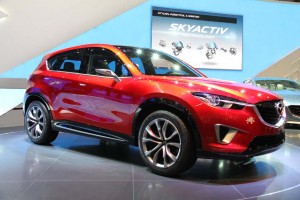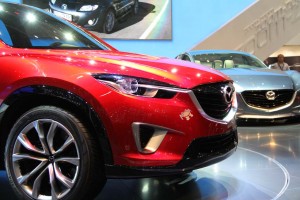
Mazda will put its new Kodo design language into production when a version of the new Minagi reaches market next year.
Mazda is a manufacturer that has often gone its very own way, from its early rotary engines to the distinctive design of the new Mazda5.
That newly updated microvan brings to the street what the maker dubbed its Nagare design language. Yet even as those flowing forms migrate to the manufacturing process, Mazda has already moved on – as it demonstrates at the Geneva Motor Show, with the unveiling of its new Minagi concept crossover vehicle.
The Mazda Minagi goes a step beyond the Shinari show car unveiled late last year, in the process introducing an all-new design language the Japanese maker dubbed Kodo, or “the soul of motion.”
 The Minagi, suggested Mazda CEO Takashi Yamanouchi, “captures the energy of the moment.”
The Minagi, suggested Mazda CEO Takashi Yamanouchi, “captures the energy of the moment.”
With its cabin notably pressed rearward, there’s a muscular, cat-like quality to the Minagi, which Mazda appropriately compares to a cheetah.”

The noses of the new Mazda Minagi (f) and Shinari concepts, which introduce the Kodo design language.
“I felt a compact crossover SUV was the perfect vehicle to express agility and focused movement; the flexibility of four limbs moving in unison, and an upright posture,” said Masashi Nakayama, Chief Designer of the Minagi Concept.
While Mazda officials described Shinari as “pure design exercise,” the Minagi is closer to a pre-production project, and the maker is already planning to follow up by revealing the production version at Europe’s next big auto show, at Frankfurt next autumn.
While showgoers will obviously focus on the styling direction the Minagi represents, the Geneva prototype serves a dual purpose, providing a platform for the all-new SkyActiv powertrain technology Mazda has been working on.
The small Japanese maker has been reluctant to embrace hybrid technology, focusing its efforts instead on squeezing out the last bit of power and mileage from the traditional internal combustion engine – with both diesel and gasoline versions of SkyActiv soon to reach the market. The Mazda Minagi show car uses the diesel version of that technology.
The production car will be one of the first to make use of the advanced powertrains, which are expected to yield a big bump in mileage and performance while sharply reducing emissions, Mazda promises. The Minagi diesel, in fact, produces about 120 grams of CO2 per kilometer compared with 150 to 170 grams for its competitors.
